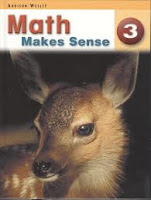In
class, we had the opportunity to explore a number of resources that are
available to assist educators of Mathematics in the province of Newfoundland
and Labrador. I found this experience extremely beneficial, for I feel more confident
in my ability to implement a lesson in Mathematics knowing that I have access
to an abundance of quality resources. To be honest, I assumed that the only
resources that would be available to us as future educators of Mathematics,
would be grade level text books and the Newfoundland and Labrador Department of
Education Curriculum Guides. Do not get me wrong, both of the resources mentioned
are significant and imperative to the delivery of Mathematics instruction; it
was just that I was pleasantly surprised to see that other resources were also
available. These resources included teacher guides, workbooks, practice and
homework books, etc.
This
experience not only introduced me to a number of resources that I had no prior exposure
to, but it also gave me the opportunity to explore the resources I was already
familiar with in greater detail. I was particularly impressed with the grade
level textbooks for both the primary and elementary grades. While I had seen
the majority of these textbooks being used in my observation days, I had never analyzed
one or compared them in terms of the mathematical outcomes, highlighted as important
in the Newfoundland and Labrador Curriculum Guides. I learned that in
Newfoundland and Labrador there are currently two separate publishing companies
responsible for the textbooks and resources used in primary and elementary Mathematics.
I was not aware of this until this experience.
Primary Mathematics
From Kindergarten to Grade three, Math Makes Sense textbooks and resources are currently being used.
After becoming
acquainted with each set of resources at the primary level, I also discovered that
the mathematical concepts taught are consistent throughout all of the primary
grades. These concepts however, increase in terms of complexity as the student moves
closer towards elementary. In other words, these textbooks support the idea of
a “spiral curriculum.” For example, throughout grade one, two and three, students
are expected to build upon their knowledge concerning patterning, addition and subtraction,
measurement, etc.
Another
thing that struck me as interesting was how different the resources for
Kindergarten were. I had never seen mathematical resources for Kindergarten
prior to this experience, so I was excited to discover that Mathematics instruction
is provided through the use of “little books.” These “little books” are
sequential in terms of content. I believe that this approach to mathematical
understanding through literacy is an exciting and appropriate way to introduce young
children to Mathematics.
Elementary Mathematics
In elementary, grades four to grade six, students are required
to use a collection of resources and materials entitled Math Focus.
Like the primary textbooks, the textbooks in elementary
seemed to embrace sequential learning. Once again, I noticed that a number of concepts
were taught throughout the grades, all increasing in terms of difficulty. These
topics include: fractions, decimals and geometry. I believe that this spiral approach
to teaching Mathematics is effective, for it allows students to build on their
prior knowledge.
Overall,
I am pleased to know that there are a number of resources available to me, as a
future educator of Mathematics. While I believe that the resources mentioned
are great, I also believe that we as teachers must be creative and authentic in
terms of the learning opportunities we provide our students with. Yes, these
resources are extremely helpful, but we must not let them limit our students’ learning
experiences.
Thanks for reading!








No comments:
Post a Comment